Olympus TOUGH TG860 review
-
-
Written by Ken McMahon
In depth
The Olympus TOUGH TG860 is a water-proof, shock-proof, freeze-proof and dust-proof compact. Launched in April 2015 it’s an update to the year-old TG850 iHS. It retains the earlier model’s 16 Megapixel CMOS sensor and the 21-105mm equivalent optical zoom, still the widest lens available on any waterproof compact. Also retained is the 3 inch 460k dot LCD screen which can flip forward for selfie shooting.
Wifi and GPS are new and the TG860 is even more rugged than its predecessor, being waterproof down to 15 metres compared to 10 metres for the TG850 iHS. There are also some new customisable buttons, enhanced continuous shooting options and new shooting modes.
Aside from the fact that it lacks RAW and costs around 20 percent less, what sets the TG860 apart from its more expensive stablemate, the TOUGH TG4, is primarily its super-wide angle lens and forward-facing screen which makes it much better suited for sports and action selfies. But it’s not limited to selfies and in some respects the screen and lens make it better suited to all kinds of outdoor photography. In my review I’ve tested and compared it to the TG4 as well as Nikon’s premium rugged waterproof compact the COOLPIX AW130. Read on to find out which is the best rugged water-proof compact for your kind of outdoor photography.
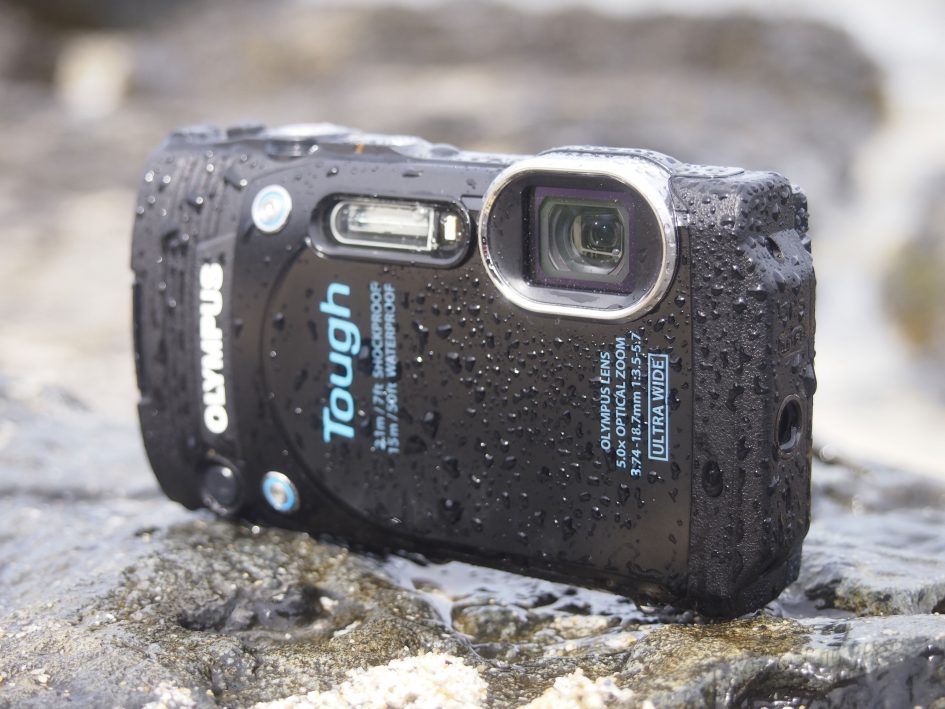
Olympus TOUGH TG860 design and controls
The TOUGH TG860 doesn’t look radically different from its predecessor – Olympus isn’t about to make dramatic changes to a popular design, my review model was finished in all black; the TG860 is also available in black with orange trim or black with a silver front panel.
The metal body of the TG860 certainly feels very robust. Measuring 113 x 64 x 28, the TG860 is fairly compact, and at 224g it’s a pretty close match in size and weight to the COOLPIX AW130. Personally though, I prefer the slightly more rounded corners of the Nikon. The dimensions of the TOUGH TG860 and the styling are also similar to the TG4, though the latter is a bit chunkier and weighs a little more. The other major difference is that, unusually for a water-proof compact, the TG4’s lens is located in the middle of the front panel, the TG860’s is more conventionally sited in the top left corner.
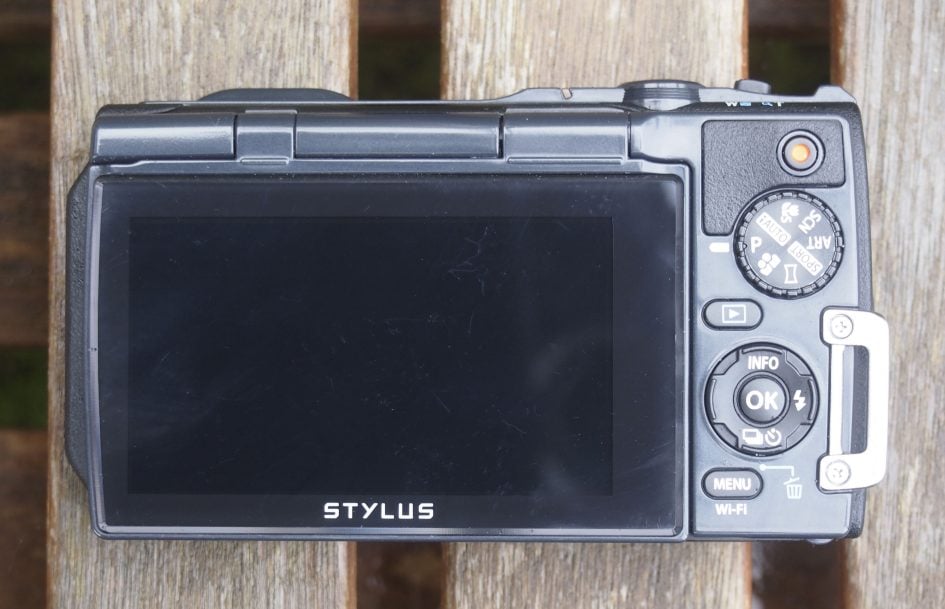
On the back the control layout is similar to the TG4 with a mode dial, four-way control pad, playback and menu buttons and a movie record button. But where the TG4 has a big silver bar to attach a strap on the right side, the TG860 has a small metal bracket screwed to the back plate. It looks a little bit like a DIY afterthought and isn’t nearly as stylish, but is less out of place on a rugged compact than it might otherwise be.
The reason for the relocation of the strap bracket is that the right side of the TOUGH TG860 accommodates a double-latched sealed door which opens to reveal the combined battery and card compartment; the mini HDMI and USB / A/V / charging port are also in here. In my view it’s a better arrangement than the twin doors on the TOUGH TG860 with fewer opportunities for water to get in. The latches on the TG860 are also bigger and easier to operate. The COOLPIX AW130 has a similar arrangement.
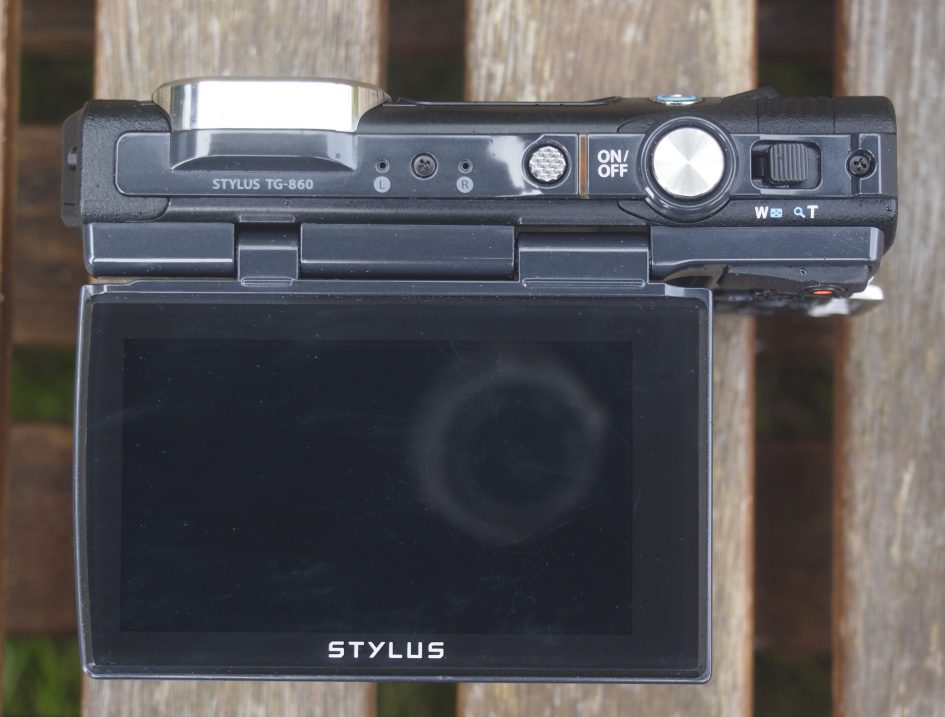
The TOUGH TG860 is unusual among water-proof models in having an articulated screen. It’s hinged at the top and can fold out and up through 180 degrees to face forward making it ideal for selfies. When facing forward the screen flips so the image is the right way up. There are no special self timer options or countdown displays which is a little disappointing, though the Self Portrait position on the mode dial provides quick access to the self portrait scene modes including underwater snapshot mode.
The screen itself measures 3 inches diagonally, but because of its 16:9 aspect ratio the full area isn’t used when shooting full resolution stills, which are 4:3 proportioned. For stills there are quite thick black bars down the sides so you get a much smaller view than on the 3:2 screen of the TG4 (though that still has narrow black bands down the sides) or the 4:3 screen of the COOLPIX AW130. It does mean that you get a much clearer view of the information overlay and settings as they appear in the black bands, rather than superimposed on the view.
That, plus the ability to flip the screen up and forwards is, I think, worth the price of a smaller view. And there’s another bonus. When shooting HD video on the TOUGH TG860 the image fills the screen and there are no black bands top and bottom as you’ll get with the TG4 and AW130. It’s just a shame the TG860 lacks a movie position on the mode dial so you can frame up your shot properly before pressing record.
The TG860’s tripod mount is located on the bottom right corner of the camera, which means the screen isn’t obstructed when the camera’s on a tripod and you can still flip it up. And of course you can easily swap cards or batteries via the side door. But there’s also a second tripod mount on the left side of the body. This could be very handy for mounting the TG860 in portrait orientation if you have a basic or mini tripod without an adjustable head.
Olympus was clearly taken with the idea of doubling up on the TG860 as there’s also a second shutter release button on the front panel. This is really handy as when the screen is flipped forward it can be tricky to get to the ‘proper’ shutter release. The front panel button is actually a programmable custom button which can be assigned to start movie recording, boost the monitor brightness, turn on the LED light, or set super Macro mode. The same set of functions can also be assigned to the movie record button on the rear.
Olympus TOUGH TG860 lens and stabilisation
The TOUGH TG860’s zoom lens has an equivalent range of 21-105mm, giving it the widest angle of view of pretty much any water-proof compact. If you want a wider angle lens you’ll need to consider either the Ricoh WG-M1 which has a 16.8mm equivalent lens giving a 160 degree viewing angle or a GoPro Hero.
You can see the field of view provided by the TG860 at either end of its zoom range below. The 21mm equivalent is significantly wider than 24mm and 25mm wide angle of the COOLPIX AW130 and TOUGH TG860 respectively.
Olympus TOUGH TG860 coverage, wide and tele
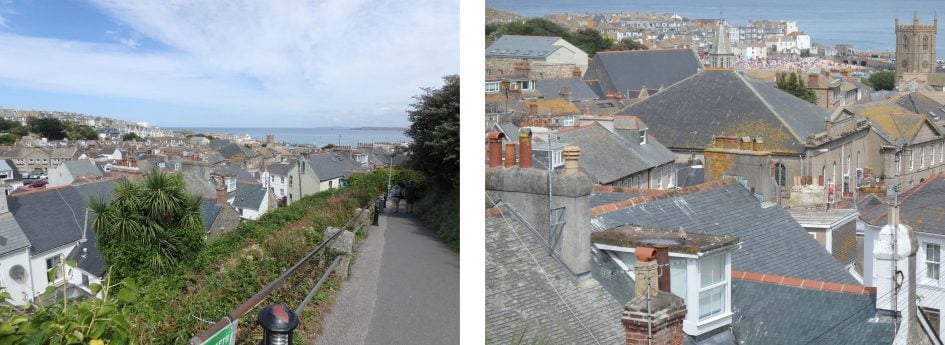
Above: Olympus TOUGH TG860 at 3.74mm (21mm equivalent) and 18.7mm (105mm equivalent)
The TG860’s maximum aperture at the wide angle setting is f3.5 closing to f5.7 at the maximum zoom. With an f2.8-4.9 lens the COOLPIX AW130 is brighter throughout the range, so a little better for low light shooting, but the TOUGH TG4 wins the award for the brightest lens – at f2-4.9 it’s over one and a half stops brighter than the TG860 at the wide angle setting. The TG4 also offers Aperture priority mode, so you can make use of the bright aperture when you want it. You can’t always rely on Auto exposure on the TG860 and AW130 to choose the brightest available aperture even in low light. In other words, if you want the best quality images in low light (which is almost always the case when shooting under water) choose the TOUGH TG4.

One of the strengths of the TOUGH models is their ability to focus on very close subjects. Like the TG4 the TG860 has a close focus distance of 1cm at the wide angle setting so you can get really close in to small subjects for macro photography. Olympus calls this Super macro and there’s a dedicated position for it on the TG860’s mode dial
You can also use the zoom to make subjects bigger in super macro mode; though its range is limited the close focus distance remains at 1cm and it’s possible to zoom in to get a lens reproduction factor of about 1:2.
Olympus Stylus TOUGH TG860 Image Stabiliser off / on
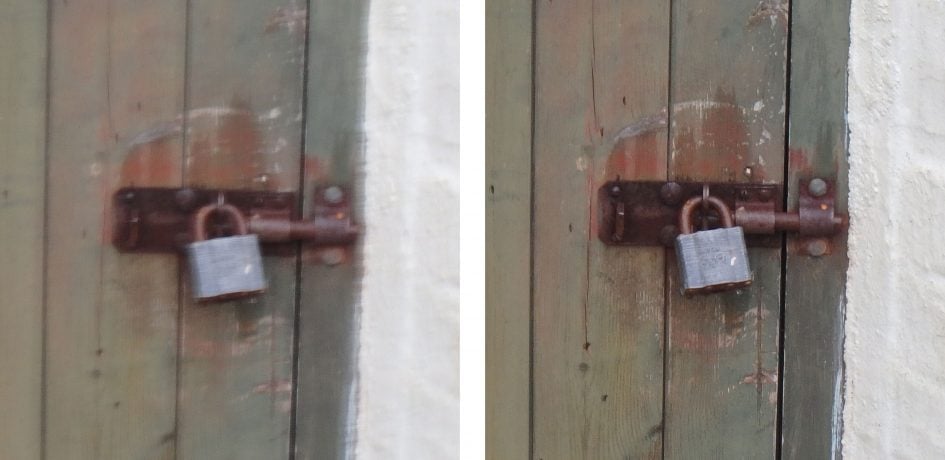
Above left: 100% crop, 3.74-18.7mm at 18.7mm, 1/6, 125 ISO, IS off. Above right: 100% crop, 3.74-18.7mm at 18.7mm, 1/6, 125 ISO, IS on.
The TOUGH TG860 lens features optical stabilisation which can be turned on or off from the camera menu. To test it I zoomed the lens in to its maximum 105mm equivalent and took a series of shots at progressively slower shutter speeds with the stabilisation turned off and then with it enabled. As you can see from the 100 percent crops above, it’s possible to hand hold the TG4 and get sharp shots down to 1/6th, four stops slower than you’d expect without stabilisation.
Olympus TOUGH TG860 movie modes
The TOUGH TG860 can shoot 1080 / 60p video and also has 720 and 480 modes both also at 60p. The 1080 / 60p mode is encoded at an average bit rate of around 28 Mbit/s which means that you’ll be able to shoot around 18 minutes of best quality video before reaching the 4GB file size limit at which point recording will stop and you will have to start a new clip. A count down timer is displayed in the bottom left corner of the screen so you can see how much time is remaining.
The TG860 has two high speed recording modes for producing slow motion video. One shoots at 120fps, slowing down the action to 1/4 normal speed and the other at 240fps for 1/8th speed playback. Both are available in 4:3 and 16:9 formats, so at 1/4 speed you can choose between 640×480 (4:3) and 854×480 (16:9) and for 1/8th speed it’s 480×360 (4:3) and 640×360 (16:9). The maximum recording time for both high speed modes is 20 seconds, giving clips of one minute and twenty seconds and two minutes forty seconds respectively.
The TOUGH TG860 has a dedicated movie record button on the rear panel just to the right of the thumb rest and a programmable button on the front that can also be used to start recording. Though not ideally suited to 4:3 stills photography, the 16:9 proportioned screen is perfect for shooting HD video which fills it edge-to-edge and top-to-bottom, a bigger and better view than you’ll get on either the TOUGH TG860 or COOLPIX AW130 both of which have 4:3 proportioned screens.As I’ve already mentioned though, it’s a shame there’s no movie position on the TG860’s mode dial as you don’t get the 16:9 view until you press the record button, though you can work round it by switching the still image ratio to 16:9.
There’s also the option to create a time lapse movie which I’ll talk about in detail in the shooting experience section below. The TOUGH TG860 has movie IS which operates independently of the stills stabilisation. Exposure control is fully automatic. You can use the optical zoom during movie shooting but, disappointingly, you can’t take photos.
Download the original file (Registered members of Vimeo only)
This clip, like the others below was shot in the TOUGH TG860’s best quality 1080/60p video mode. The quality is good and, though there’s an odd wobble at the beginning of the clip, the stabilisation keeps things steady. The AF wanders a little during the zoom and there’s an unpleasant grinding noise at the beginning and end of the zoom.
Download the original file (Registered members of Vimeo only)
For this second clip the camera was mounted on a tripod and stablisation was disabled. The 60fps footage is rock steady and the quality looks very good. The AF wanders a bit during the zoom but recovers quickly. There’s that noise from the zoom again which I strongly suspect is a specific issue with our review model.
Download the original file (Registered members of Vimeo only)
The TG860 performs very well in this low light interior. Yes, there’s noise, but you need to be looking for it to notice. The AF is rock solid and the exposure adjusts very smoothly in the middle of the pan, though maybe a little too much. The white balance is also handled well.
Download the original file (Registered members of Vimeo only)
For this clip I tested the TOUGH TG860’s continuous AF performance by zooming the lens in slightly and panning from the coffee cup on the table up to the bar and back again. The continuous AF does reasonably well, particularly when moving from the cup to the bar. In the other direction there’s a little bit of to and fro as the contrast-detect AF system tries to determine whether it’s focused in front of or behind it.
Download the original file (Registered members of Vimeo only)
Finally, here’s an example of the TOUGH TG860’s high speed mode in action. This was shot in the 240fps 480×360 mode, there’s also a 16:9 option – not much happens until 30 seconds in so you might want to fast forward to that point.
Olympus TOUGH TG860 shooting experience
The TOUGH TG860 looks the part, but despite its rugged appearance it isn’t as easy to keep hold of or operate in the water as it could be. There’s a ridged plastic panel on the front, but it’s too far to the left to be of any practical use and the natural place for your fingers to grip is the raised bar with the Olympus branding, except it’s not that grippy. In fact the TG860 could do with more soft grip material altogether. The thumb rest is a smooth ever so slightly contoured surface across which your thumb easily slides.
On a more positive note, the second shutter release on the front of the camera is one of the TG860’s best physical features. At first I though it had been poorly positioned because if you hold the camera in landscape format facing towards you for a selfie, pressing the button with your thumb leaves you with a very little to hold onto, in fact you’re better off using the conventional shutter release. But if you hold the TG860 upside down with the screen extending below it all works much better, you can grip, frame and shoot comfortably with no danger of dropping the camera.
Press the OK button at the centre of the control pad and you can navigate 8 function menu options displayed down the right side of the screen each of which activates a fly-out menu when selected. All the really useful stuff is here including picture mode, white balance exposure compensation, ISO sensitivity, drive mode and Image size.
You can directly access the flash and drive mode options on the menu from the right and bottom positions on the control pad with the top position used to cycle display overlays including a grid and live histogram.. It’s a shame there isn’t a dedicated button for ISO sensitivity, which takes four presses on the down pad to reach, though you can reduce that to two by pressing the drive mode button and going up one. Another disappointing ommission is there’s no tap control – the TG4 feature that allows you to navigate the menu by tapping the camera.
The TOUGH TG860’s mode dial and function menu work together to make for very easy operation both in and out of the water. It’s a shame that there’s no underwater mode position on the dial, as on the TOUGH TG4. The TG860’s underwater modes are on the Scene mode menu, so as long as you have an underwater scene mode selected, turning the mode dial to the SCN position will get you there. There are three underwater modes – snapshot, wide 1, (for landscapes) wide 2 (for action) and macro.
Switch the TG860’s mode dial to the sport position and you can access features specifically tailored to shooting action sequences. Some of these are the same movie modes that you can access in any other mode from the function menu i.e. 1080 / 60p 720 / 60p 480 / 60p and the high speed modes. But beyond that the function menu also provides a couple of new options.
The first of these is Time-lapse movie which takes a sequence of 3 Megapixel shots at a set interval between 0.5 and 30 seconds and combines them into a 1080p, 720p or 480p movie for you. The TG860 keeps on shooting at the set interval until you press the shutter release a second time. According to the manual the maximum recording time is 24 hours, though the battery would of course give up long before that.
Sport burst is an interval timer that can be set to take 3 Megapixel shots at specific intervals with options for 0.05 (20fps) 0.4 (2.5fps) 1, 2, 5, 10, 30, and 60 seconds. This is useful for situations where you’re not able to frame up and take shots because you’re busy with other things – like holding on to a rock face or trying to catch waves. Of course you still have to hold the camera and point it at something ,unless you’re able to mount it somewhere and a tripod isn’t going to be an option in the kind of environments the TG860 was designed for. Sadly there are no mounting accessories of the kind readily available for GoPro and other action cameras.
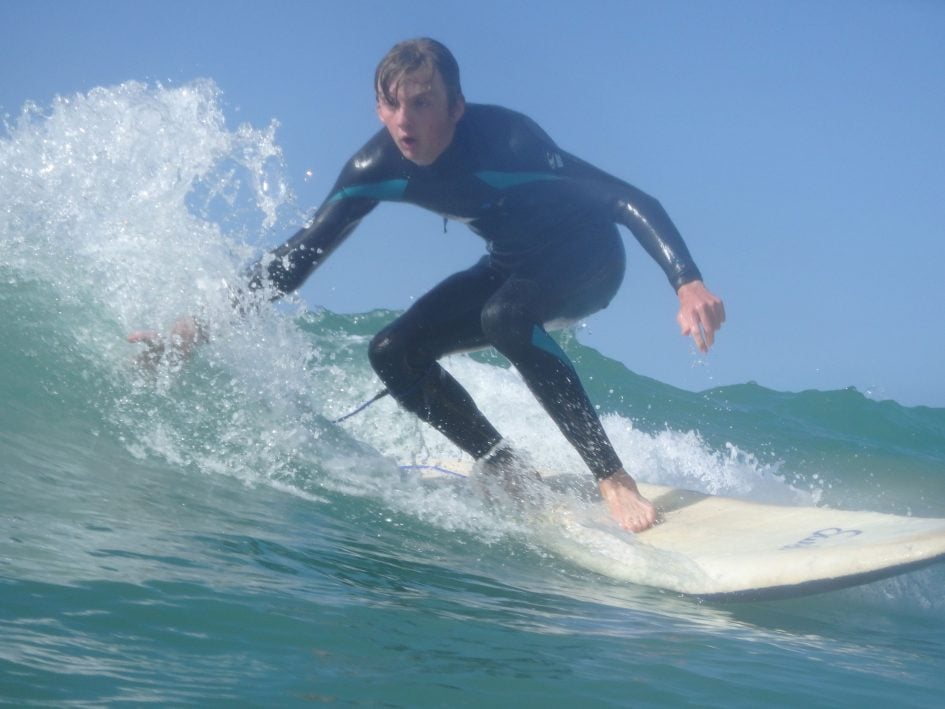
Above: 1/800, f5.7, 125 ISO, 18.7mm (105mm equivalent) Sequential 2 (7fps) mode
The TG860 can shoot a burst of full resolution images at 7fps for 7 frames, in other words a one-second burst. I tested it with a high speed UHS-1 SD card fitted and it fired off exactly 7 frames at 7.14fps. That’s fine for very short bursts of action, but it’s not really enough to capture sequences of surfing or wakeboarding for example. But it is useful for grabbing a short sequence from which you can take the best shot – so long as the subject doesn’t move towards or away from the camera too much – the TG860 fixes the focus and exposure on the first frame.
For longer sequences there’s a 2.5fps mode that has a 200 frame limit, but if you want to capture longer fast action sequences you’re better off using the reduced resolution 3 Megapixel 20fps mode which has a 60 frame limit – or 3 seconds. You can also shoot 3 megapixel images at 60fps, but the limit is still 60 frames so you’re back to just one second of action.
The TOUGH TG4 is better equipped for continuous shooting with a 5fps full resolution mode that keeps going for 100 frames, or 20 seconds as well as the same reduced resolution modes as the TOUGH TG860. At full resolution the COOLPIX AW130 is limited to 5 frames at 7fps but like the TG860 has faster low resolution continuous shooting modes available.
The TG860 has three autofocus modes; Face iESP focuses on a face if there is one in the frame and if not defaults to 25-area AF. Spot selects a single central AF area and finally, AF tracking follows a moving object. The TG860 also allows you to lock focus by pressing ok button in the Sport, Super macro, and Underwater modes.
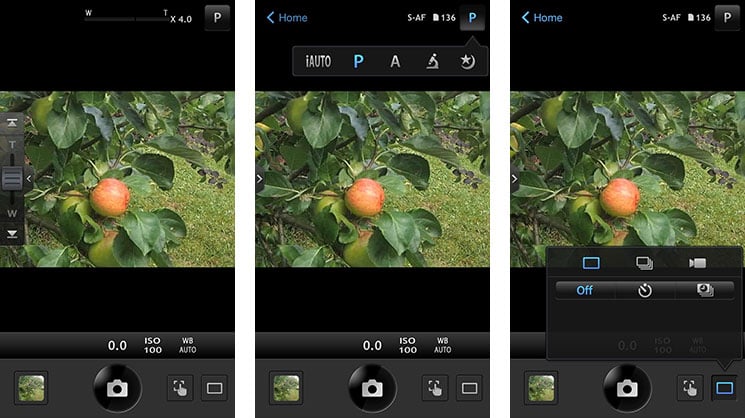
The TG860 has built in GPS and Wifi, allowing you to tag your photos with positional information, wirelessly transfer them to your phone and upload them to the Web and remotely control the camera with a smartphone. Neither the GPS nor the Wifi features were functioning on my review model, so what follows is a description of the same features tested on the TOUGH TG4.
The GPS provides lat and long co-ordinates of your current position which are added to the image metadata, allowing software to locate your photos on a map. The GPS can also record a track log; you can’t display your route on the camera but you can use the supplied Olympus Viewer 3 or OI. Track software or a third party application. Like the TG4, the TG860 has a built-in manometer that provides altitude and depth reporting, but there’s no electronic compass display.
The TOUGH TG860 features built-in Wifi which you can use to connect to a smartphone for picture sharing, GPS tagging and remote control. To use the Wifi you’ll need the Olympus Image Share app which is currently available for Android and iOS devices.
Setting up a secure wireless connection with the TOUGH TG860 is made simple using a QR code to generate a connection profile. To start a Wifi connection you press and hold the menu button in playback mode. A QR code is then displayed which you scan using the Image Share app to automatically set up a connection.
There are two connection options, one-time, which uses a unique password for when you just want to share a few selected images with friends, and Private, which allows you to connect using the same password each time. So when using your own phone you only have to go through the QR scanning routine once, after which you just turn on the Wifi and select it from your phone settings in the same way you would any other access point.
Once connected the app offers four main options: Remote Control, Import Photos, Edit Photo and Add Geotag. Tapping Remote Control lets you see a live image from the camera and refocus it by tapping on your phone or tablet’s screen. Impressively you can remotely change the exposure mode without touching the camera’s mode dial. Depending on the selected mode, you can then tap to adjust exposure compensation, ISO and white balance, along with changing the drive mode, and of course triggering the exposure. The drive mode menu also has an option for movie recording which uses the movie mode currently set on the camera.
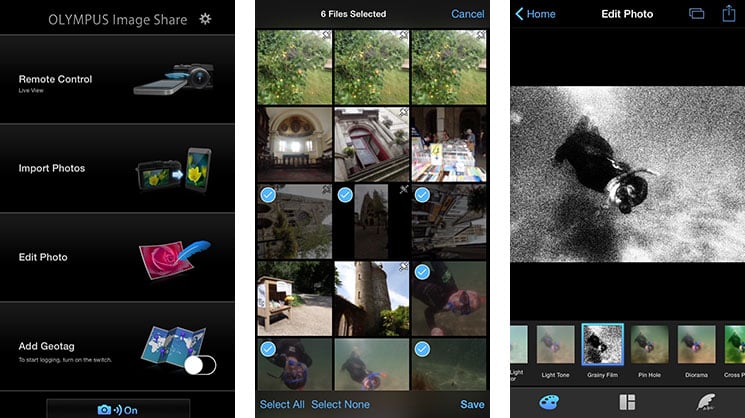
New to the latest version of the app is the ability to configure a basic interval timer or trigger a short movie recording of up to 16 seconds. The interval timer is more like an advanced self-timer, taking no more than ten shots at intervals no greater than 3 seconds, but it’s still a handy update, and you can also configure it to capture bursts (for burst shooting the maximum interval is 30 seconds) or movies instead if preferred. If you choose to record movies remotely with the camera, sadly, you can’t touch the screen to reposition the AF area or pull-focuss.
Photos can be imported to a smartphone at their original resolution or a range of smaller sizes down to 1024×768, but everything has to go via the phone app, there’s no way to backup files directly to a computer using either a peer to peer connection or via a wireless LAN. The camera is always setup as the access point and, though you can connect to it with devices other than your phone, there’s no way to access images other than with the app. The Olympus Viewer 3 software can’t access the camera even when you’re connected to it via Wifi, which is a shame.
Choosing Edit Photo lets you perform a number of adjustments on images that have already been copied onto your handset. You can apply Art Filters, superimpose text, logos, even signatures written on your phone’s touchscreen, and play around with composite Photo Story arrangements.
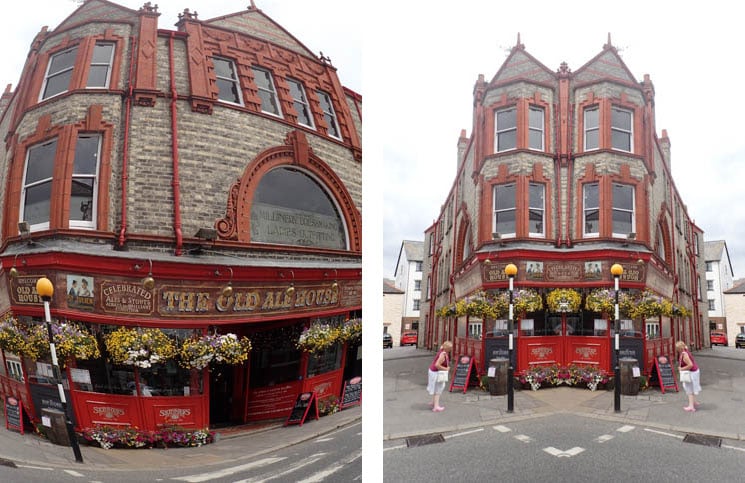
Above left: Olympus TOUGH TG860 : Fish Eye. Above right: Olympus TOUGH TG860 : Reflection.
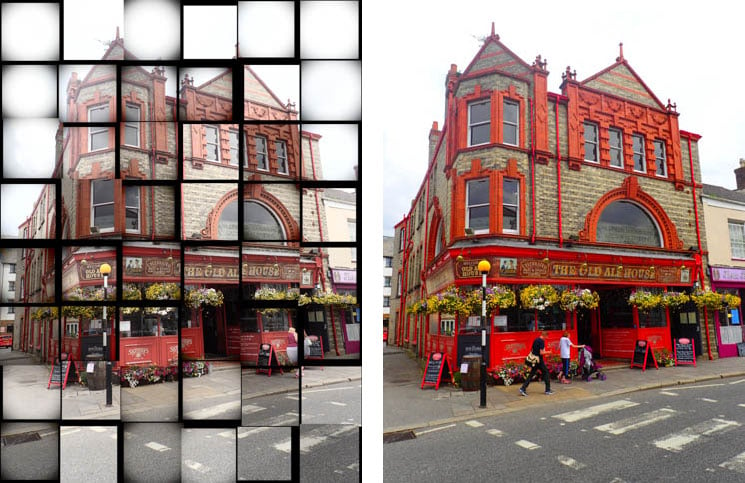
Above left: Olympus TOUGH TG860 : Fragmented. Above right: Olympus TOUGH TG860 : Pop Art.
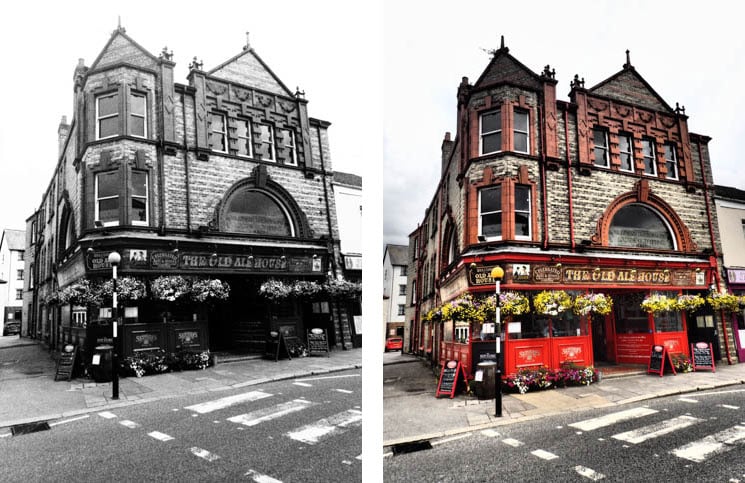
Above left: Olympus TOUGH TG860 : Pale & Light Colour. Above right: Olympus TOUGH TG860 : Grainy Film.
For situations when even the widest angle zoom lens of any water-proof compact isn’t enough, the TOUGH TG860 also has a panorama mode with the option to shoot a 180 degree or 360 degree view. You can pan left or right, up or down, the TG4 works it out and automatically shoots overlapping images and combines them. Alternatively in manual mode you get to frame and shoot three images which the camera then uses to produce the panorama.
And of course it wouldn’t be an Olympus with Art filters. Switch to the Art position on the mode dial and you can choose from seven filters – Pop Art, Soft Focus, Pale & Light Colour, Grainy Film, Pin hole, Diorama (miniature), and Dramatic Tone art filters. You can also select the filters in other modes from the Picture mode flyout on the quick menu. In addition to the Vivid, Natural and Muted picture modes you’ll find the seven art filters I’ve already mentioned plus Fish Eye, Sparkle, Reflection and Fragmented, some of which are shown above.
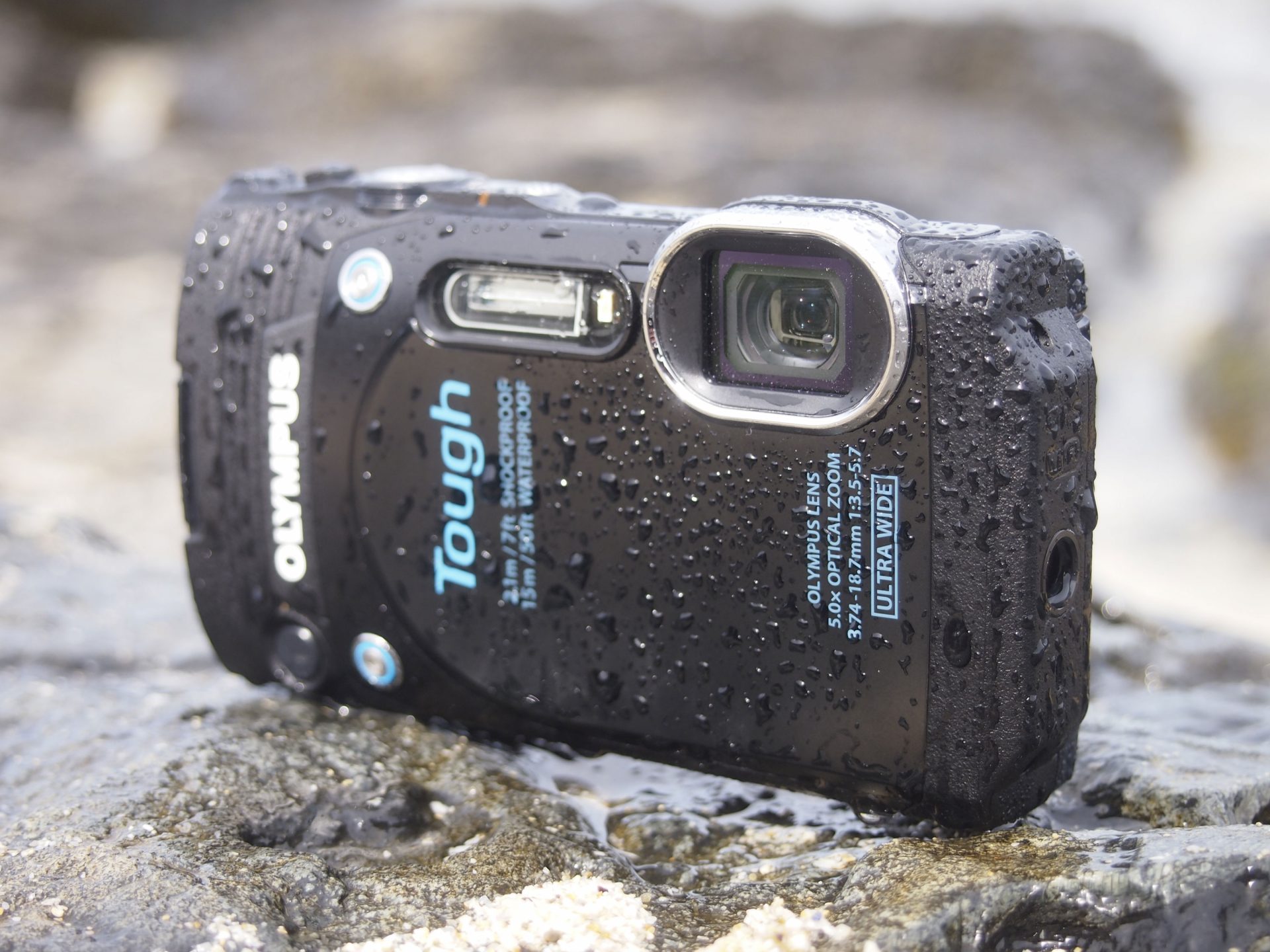
 I think the TOUGH TG860 is the real star in the Olympus rugged line-up. It offers a superior zoom, more versatile screen, better video and better support for shooting sports and action subjects all at a lower price than the TG4. You sacrifice the RAW mode, which is something a lot of people will be able to live without. A bigger loss is the bright f2-4.9 aperture of the TG4 but despite that the TOUGH TG860 remains a compelling alternative. As it stands in the current crop of waterproof cameras, the TG860 earns our Highly Recommended rating.
I think the TOUGH TG860 is the real star in the Olympus rugged line-up. It offers a superior zoom, more versatile screen, better video and better support for shooting sports and action subjects all at a lower price than the TG4. You sacrifice the RAW mode, which is something a lot of people will be able to live without. A bigger loss is the bright f2-4.9 aperture of the TG4 but despite that the TOUGH TG860 remains a compelling alternative. As it stands in the current crop of waterproof cameras, the TG860 earns our Highly Recommended rating.



